Michael Ying Yang
Scale-wise Bidirectional Alignment Network for Referring Remote Sensing Image Segmentation
Jan 06, 2025Abstract:The goal of referring remote sensing image segmentation (RRSIS) is to extract specific pixel-level regions within an aerial image via a natural language expression. Recent advancements, particularly Transformer-based fusion designs, have demonstrated remarkable progress in this domain. However, existing methods primarily focus on refining visual features using language-aware guidance during the cross-modal fusion stage, neglecting the complementary vision-to-language flow. This limitation often leads to irrelevant or suboptimal representations. In addition, the diverse spatial scales of ground objects in aerial images pose significant challenges to the visual perception capabilities of existing models when conditioned on textual inputs. In this paper, we propose an innovative framework called Scale-wise Bidirectional Alignment Network (SBANet) to address these challenges for RRSIS. Specifically, we design a Bidirectional Alignment Module (BAM) with learnable query tokens to selectively and effectively represent visual and linguistic features, emphasizing regions associated with key tokens. BAM is further enhanced with a dynamic feature selection block, designed to provide both macro- and micro-level visual features, preserving global context and local details to facilitate more effective cross-modal interaction. Furthermore, SBANet incorporates a text-conditioned channel and spatial aggregator to bridge the gap between the encoder and decoder, enhancing cross-scale information exchange in complex aerial scenarios. Extensive experiments demonstrate that our proposed method achieves superior performance in comparison to previous state-of-the-art methods on the RRSIS-D and RefSegRS datasets, both quantitatively and qualitatively. The code will be released after publication.
Learning from Exemplars for Interactive Image Segmentation
Jun 17, 2024Abstract:Interactive image segmentation enables users to interact minimally with a machine, facilitating the gradual refinement of the segmentation mask for a target of interest. Previous studies have demonstrated impressive performance in extracting a single target mask through interactive segmentation. However, the information cues of previously interacted objects have been overlooked in the existing methods, which can be further explored to speed up interactive segmentation for multiple targets in the same category. To this end, we introduce novel interactive segmentation frameworks for both a single object and multiple objects in the same category. Specifically, our model leverages transformer backbones to extract interaction-focused visual features from the image and the interactions to obtain a satisfactory mask of a target as an exemplar. For multiple objects, we propose an exemplar-informed module to enhance the learning of similarities among the objects of the target category. To combine attended features from different modules, we incorporate cross-attention blocks followed by a feature fusion module. Experiments conducted on mainstream benchmarks demonstrate that our models achieve superior performance compared to previous methods. Particularly, our model reduces users' labor by around 15\%, requiring two fewer clicks to achieve target IoUs 85\% and 90\%. The results highlight our models' potential as a flexible and practical annotation tool. The source code will be released after publication.
Compositional 3D Scene Synthesis with Scene Graph Guided Layout-Shape Generation
Mar 19, 2024



Abstract:Compositional 3D scene synthesis has diverse applications across a spectrum of industries such as robotics, films, and video games, as it closely mirrors the complexity of real-world multi-object environments. Early works typically employ shape retrieval based frameworks which naturally suffer from limited shape diversity. Recent progresses have been made in shape generation with powerful generative models, such as diffusion models, which increases the shape fidelity. However, these approaches separately treat 3D shape generation and layout generation. The synthesized scenes are usually hampered by layout collision, which implies that the scene-level fidelity is still under-explored. In this paper, we aim at generating realistic and reasonable 3D scenes from scene graph. To enrich the representation capability of the given scene graph inputs, large language model is utilized to explicitly aggregate the global graph features with local relationship features. With a unified graph convolution network (GCN), graph features are extracted from scene graphs updated via joint layout-shape distribution. During scene generation, an IoU-based regularization loss is introduced to constrain the predicted 3D layouts. Benchmarked on the SG-FRONT dataset, our method achieves better 3D scene synthesis, especially in terms of scene-level fidelity. The source code will be released after publication.
Robust Shape Fitting for 3D Scene Abstraction
Mar 15, 2024



Abstract:Humans perceive and construct the world as an arrangement of simple parametric models. In particular, we can often describe man-made environments using volumetric primitives such as cuboids or cylinders. Inferring these primitives is important for attaining high-level, abstract scene descriptions. Previous approaches for primitive-based abstraction estimate shape parameters directly and are only able to reproduce simple objects. In contrast, we propose a robust estimator for primitive fitting, which meaningfully abstracts complex real-world environments using cuboids. A RANSAC estimator guided by a neural network fits these primitives to a depth map. We condition the network on previously detected parts of the scene, parsing it one-by-one. To obtain cuboids from single RGB images, we additionally optimise a depth estimation CNN end-to-end. Naively minimising point-to-primitive distances leads to large or spurious cuboids occluding parts of the scene. We thus propose an improved occlusion-aware distance metric correctly handling opaque scenes. Furthermore, we present a neural network based cuboid solver which provides more parsimonious scene abstractions while also reducing inference time. The proposed algorithm does not require labour-intensive labels, such as cuboid annotations, for training. Results on the NYU Depth v2 dataset demonstrate that the proposed algorithm successfully abstracts cluttered real-world 3D scene layouts.
Convincing Rationales for Visual Question Answering Reasoning
Feb 06, 2024Abstract:Visual Question Answering (VQA) is a challenging task of predicting the answer to a question about the content of an image. It requires deep understanding of both the textual question and visual image. Prior works directly evaluate the answering models by simply calculating the accuracy of the predicted answers. However, the inner reasoning behind the prediction is disregarded in such a "black box" system, and we do not even know if one can trust the predictions. In some cases, the models still get the correct answers even when they focus on irrelevant visual regions or textual tokens, which makes the models unreliable and illogical. To generate both visual and textual rationales next to the predicted answer to the given image/question pair, we propose Convincing Rationales for VQA, CRVQA. Considering the extra annotations brought by the new outputs, {CRVQA} is trained and evaluated by samples converted from some existing VQA datasets and their visual labels. The extensive experiments demonstrate that the visual and textual rationales support the prediction of the answers, and further improve the accuracy. Furthermore, {CRVQA} achieves competitive performance on generic VQA datatsets in the zero-shot evaluation setting. The dataset and source code will be released under https://github.com/lik1996/CRVQA2024.
Transformer-based Multimodal Change Detection with Multitask Consistency Constraints
Oct 21, 2023



Abstract:Change detection plays a fundamental role in Earth observation for analyzing temporal iterations over time. However, recent studies have largely neglected the utilization of multimodal data that presents significant practical and technical advantages compared to single-modal approaches. This research focuses on leveraging digital surface model (DSM) data and aerial images captured at different times for detecting change beyond 2D. We observe that the current change detection methods struggle with the multitask conflicts between semantic and height change detection tasks. To address this challenge, we propose an efficient Transformer-based network that learns shared representation between cross-dimensional inputs through cross-attention. It adopts a consistency constraint to establish the multimodal relationship, which involves obtaining pseudo change through height change thresholding and minimizing the difference between semantic and pseudo change within their overlapping regions. A DSM-to-image multimodal dataset encompassing three cities in the Netherlands was constructed. It lays a new foundation for beyond-2D change detection from cross-dimensional inputs. Compared to five state-of-the-art change detection methods, our model demonstrates consistent multitask superiority in terms of semantic and height change detection. Furthermore, the consistency strategy can be seamlessly adapted to the other methods, yielding promising improvements.
BuilDiff: 3D Building Shape Generation using Single-Image Conditional Point Cloud Diffusion Models
Aug 31, 2023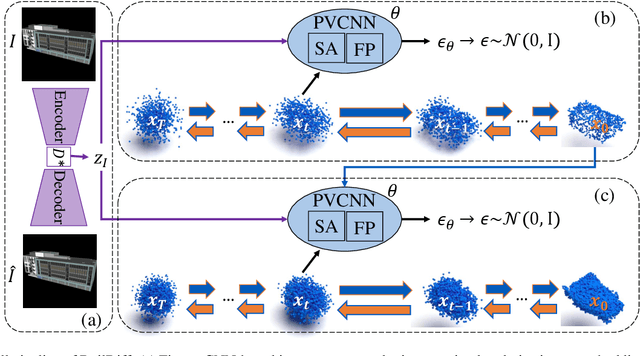
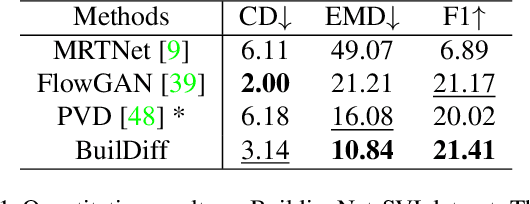
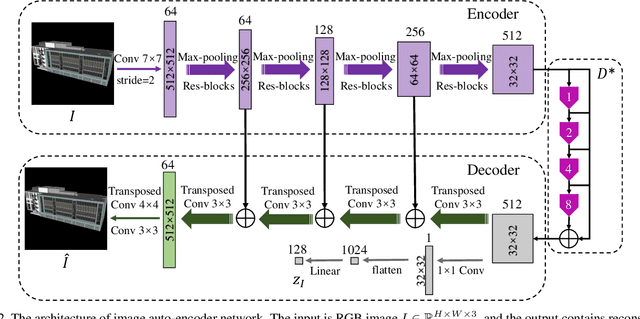
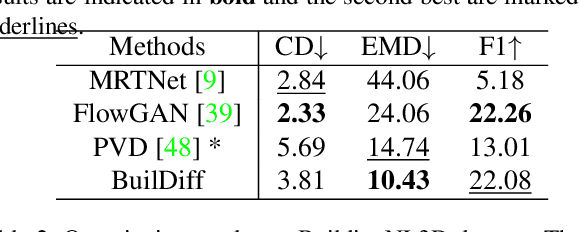
Abstract:3D building generation with low data acquisition costs, such as single image-to-3D, becomes increasingly important. However, most of the existing single image-to-3D building creation works are restricted to those images with specific viewing angles, hence they are difficult to scale to general-view images that commonly appear in practical cases. To fill this gap, we propose a novel 3D building shape generation method exploiting point cloud diffusion models with image conditioning schemes, which demonstrates flexibility to the input images. By cooperating two conditional diffusion models and introducing a regularization strategy during denoising process, our method is able to synthesize building roofs while maintaining the overall structures. We validate our framework on two newly built datasets and extensive experiments show that our method outperforms previous works in terms of building generation quality.
Tracing the Influence of Predecessors on Trajectory Prediction
Aug 10, 2023Abstract:In real-world traffic scenarios, agents such as pedestrians and car drivers often observe neighboring agents who exhibit similar behavior as examples and then mimic their actions to some extent in their own behavior. This information can serve as prior knowledge for trajectory prediction, which is unfortunately largely overlooked in current trajectory prediction models. This paper introduces a novel Predecessor-and-Successor (PnS) method that incorporates a predecessor tracing module to model the influence of predecessors (identified from concurrent neighboring agents) on the successor (target agent) within the same scene. The method utilizes the moving patterns of these predecessors to guide the predictor in trajectory prediction. PnS effectively aligns the motion encodings of the successor with multiple potential predecessors in a probabilistic manner, facilitating the decoding process. We demonstrate the effectiveness of PnS by integrating it into a graph-based predictor for pedestrian trajectory prediction on the ETH/UCY datasets, resulting in a new state-of-the-art performance. Furthermore, we replace the HD map-based scene-context module with our PnS method in a transformer-based predictor for vehicle trajectory prediction on the nuScenes dataset, showing that the predictor maintains good prediction performance even without relying on any map information.
Interactive Image Segmentation with Cross-Modality Vision Transformers
Jul 05, 2023
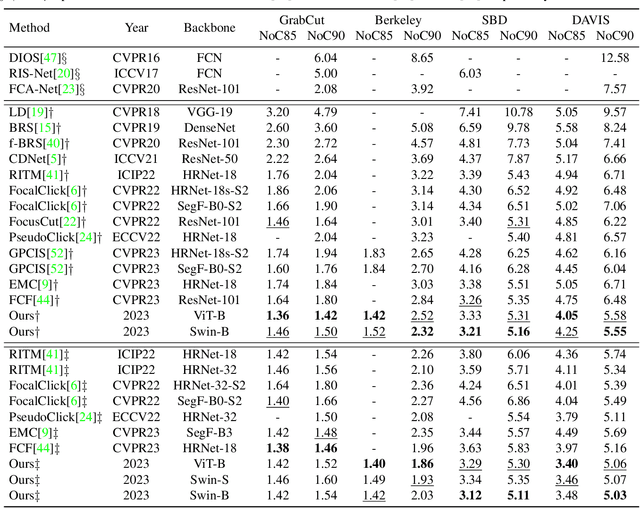

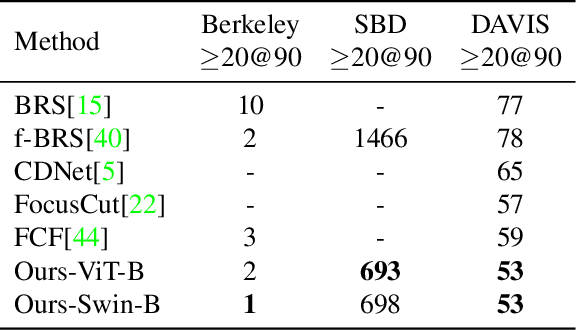
Abstract:Interactive image segmentation aims to segment the target from the background with the manual guidance, which takes as input multimodal data such as images, clicks, scribbles, and bounding boxes. Recently, vision transformers have achieved a great success in several downstream visual tasks, and a few efforts have been made to bring this powerful architecture to interactive segmentation task. However, the previous works neglect the relations between two modalities and directly mock the way of processing purely visual information with self-attentions. In this paper, we propose a simple yet effective network for click-based interactive segmentation with cross-modality vision transformers. Cross-modality transformers exploits mutual information to better guide the learning process. The experiments on several benchmarks show that the proposed method achieves superior performance in comparison to the previous state-of-the-art models. The stability of our method in term of avoiding failure cases shows its potential to be a practical annotation tool. The code and pretrained models will be released under https://github.com/lik1996/iCMFormer.
Learning Similarity between Scene Graphs and Images with Transformers
Apr 02, 2023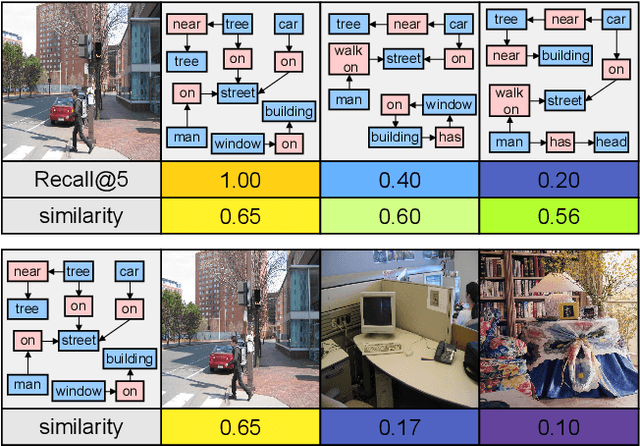

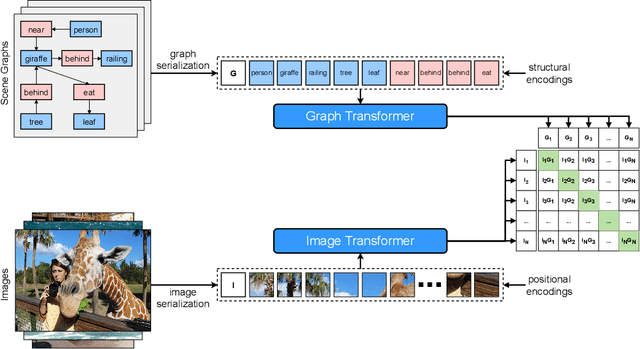

Abstract:Scene graph generation is conventionally evaluated by (mean) Recall@K, which measures the ratio of correctly predicted triplets that appear in the ground truth. However, such triplet-oriented metrics cannot capture the global semantic information of scene graphs, and measure the similarity between images and generated scene graphs. The usability of scene graphs is therefore limited in downstream tasks. To address this issue, a framework that can measure the similarity of scene graphs and images is urgently required. Motivated by the successful application of Contrastive Language-Image Pre-training (CLIP), we propose a novel contrastive learning framework consisting of a graph Transformer and an image Transformer to align scene graphs and their corresponding images in the shared latent space. To enable the graph Transformer to comprehend the scene graph structure and extract representative features, we introduce a graph serialization technique that transforms a scene graph into a sequence with structural encoding. Based on our framework, we introduce R-Precision measuring image retrieval accuracy as a new evaluation metric for scene graph generation and establish new benchmarks for the Visual Genome and Open Images datasets. A series of experiments are further conducted to demonstrate the effectiveness of the graph Transformer, which shows great potential as a scene graph encoder.
 Add to Chrome
Add to Chrome Add to Firefox
Add to Firefox Add to Edge
Add to Edge